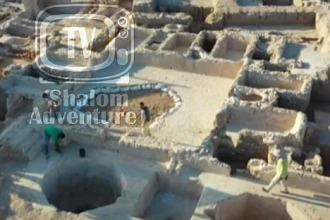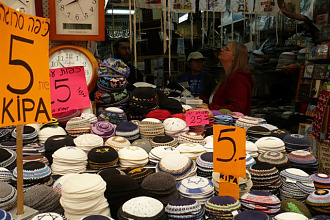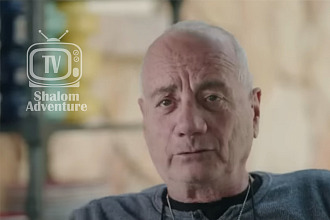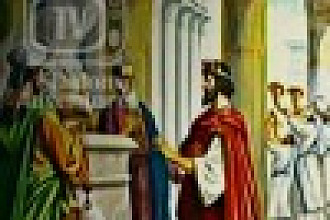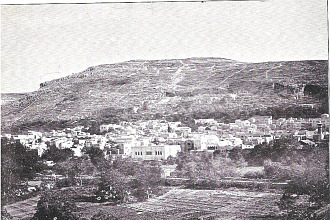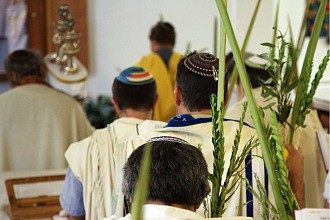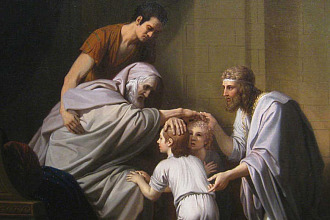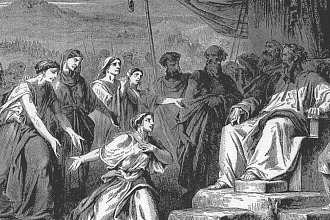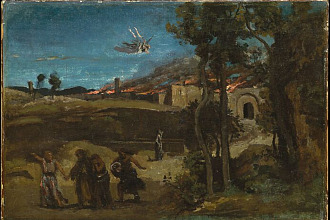Parasha for the Week: Vayachel-Pukidey: Exodus 35:1 – 40:38
Haftarah for the Week: 1 Kings 7:13 - 8:21
Apostolic Writings: John 14:15 - 26
Moshe Rabbeinu exhorts Bnei Yisrael (children of Israel) to keep Shabbat, and requests donations for the materials for making the Mishkan. He collects gold, silver, precious stones, skins and yarn, as well as incense and olive oil for the menorah and for anointing.
The princes of each tribe bring the precious stones for the Kohen Gadol’s breastplate and ephod.
G-d appoints Betzalel and Oholiav as the master craftsmen.
Bnei Yisrael contribute so much that Moshe begins to refuse donations.
Special curtains with two different covers were designed for the Mishkan’s roof and door.
Gold-covered boards in silver bases were connected, forming the Mishkan’s walls.
Betzalel made the Holy Ark (which contained the Tablets) from wood cov-ered with gold.
On the Ark’s cover were two figures facing each other.
The menorah and the table with the showbreads were also of gold.
Two altars were made: a small incense altar of wood overlaid with gold, and a larger altar for sacrifices made of wood covered with copper.
Pukidey
The Book of Shemot concludes with this Parasha. After finishing all the different parts, vessels and garments used in the Mishkan, Moshe gives a complete accounting and enumeration of all the contributions and of the various clothing and vessels which had been fashioned. Bnei Yisrael bring everything to Moshe.
He inspects the handiwork and notes that everything was made according to G-d’s specifications.
Moshe blesses the people. G-d speaks to Moshe and tells him that the Mishkan should be set up on the first day of the first month, (Nissan). He also tells Moshe the order of assembly for the Mishkan and its vessels. Moshe does everything in the prescribed manner.
When the Mishkan is finally complete with every vessel in its place, a cloud descends upon it, indicating that G-d’s glory was resting there. Whenever the cloud moved away from the Mishkan, Bnei Yisrael would follow it. At night the cloud was replaced by a pillar of fire..
THE FIRST MONTH oF THE YEAR
The Jewish calendar was established at the Exodus. Before the liberation from Egypt there is no evidence in the Bible of a calendar except the Shabbat which was given at the creation. At the time of the liberation from Egypt, G-d designated Nissan to be the first months of the year. But later, the month of Tishri, which was originally the seventh, became the first. We can say that the Jewish people have two first months. Nissan month of Pesach, and Tishrei the month of Rosh Hashana.
Jewish scholars explain the difference between the month of Tishrei and Nissan in this way: G-d rules the world at two levels; through “nature” and through “miracles.”
The month of Tishrei represents the birth of the universe. It represents creation and the laws of nature. But Nissan represents miracles. The name Nissan is from the word Nes which means miracle. For in the month of Nissan the greatest of all miracles happened, when the Jewish people were liberated from Egypt.
G-d designated Nissan as the first month to teach us that the existence and future of G-d’s people is not a natural phenomenon, but is essentially miraculous. Now over 3,400 years after the Exodus, we still continue to see that the existence of G-d’s people is only due to G-d’s miracles. We all remember that another great miracle occurred on Nissan, the coming and the revelation of the Mashiach in Nissan of the year 31 CE.
DONE AS THE L-RD COMMANDED
The last verse of chapter 39 gives us the appreciation of Moshe on the work done in the Sanctuary, “And Moses saw all the work, and behold, they had done it; as the L-rd had commanded, so had they done it.” (Exodus 39:43). He noted that the work bore two distinct characteristics: 1) Assu Otah, they had done it: every part of the work, from the smallest to the largest, expressed the whole personality, the devotion, the enthusiastic responsiveness, and the dynamism of the entire nation. 2) Ka’asher tsiva Adonai… As G-d commanded Their zeal and enthusiasm had been subordinated completely — both communally and individually — to the Divine command. There had been no attempt on the part of any craftsman to bring his own ideas and his own individuality to bear upon the work by making additions or omissions. Rather, for each and every one of the craftsman, this was his greatest reward: to carry out G-d’s command and intention with scrupulous care and precision.
The Sages of Israel find the content of his blessing in the concluding verse of his great prayer (Tehillim 90). Moshe bestows his highest blessing and expresses the fervent wish that this obedience in freedom should ever remain the chief characteristic of a Jewish life of mitsvot. Rabbi Hirsch says “That tefilla concludes with the words: ‘May Your work become manifest to Your servants and may Your glory remain with their children! May the bliss of G-d our L-rd remain our lot; let the work of our hands be established upon us, and may You establish the work of our hands, the first “and establish the work of our hands upon us;” (Psalms 90:17) is about freedom and the second “yes, establish the work of our hands!” (Psalms 90:17) is about obedience. Only both of these together, in intimate union, assure us of the bliss, that G-d prepares for us if we dedicate ourselves to Him as our L-rd, our Master.
ESTABLISHMENT OF THE SANCTUARY
The Torah repeats for the second time that the Sanctuary was established on the first day of the month “In the first month in the second year, on the first day of the month, the tabernacle was erected.” (Exodus 40:17), and according to the Torah, the erection of the Sanctuary, was accompanied by the initiation (miluim) and dedication of the Kohanim that lasted seven days “Thus you shall do to Aaron and to his sons, according to all that I have commanded you. Through seven days shall you ordain them” (Exodus 29:35). During all this period of seven days Moshe initiated the Kohanim each day to the procedures of offerings and sacrifices. In the Jewish tradition it is said that on each day of the initiation Moshe would set up the Sanctuary, anoint it, and dismantle it. But on the first of Nissan he set it up, anointed it and did not dismantle it. Thus according to the law of the Mishkan the erection of the Mishkan on the first of Nissan was final and permanent. The Jewish people have seen these seven constructions of the Sanctuary as a prophecy about the Mishkan which was built up seven time, in five different places between Moses and David and then as the Beth Harishon (the first Temple) and then the Beth Sheni, the second Temple and the last one, the eighth and will be the heavenly Jerusalem which will come from heaven with Mashiach.
Haftara: 1 Kings 7:13 - 8:21
In parasha Vayak’hel G-d asks Israel to continue to build the sanctuary, Moses choose Betzalel for all artistic work because he was skilled. “Then Moses said to the Israelites: See, the L-rd has called by name Betzalel son of Uri son of Hur, of the tribe of Judah; he has filled him with divine spirit, with skill, intelligence, and knowledge in every kind of craft, to devise artistic designs, to work in gold, silver, and bronze… ” (Exodus 35:30-3).
About four hundred years later, Solomon choose in the Haftara Hiram from Tyre for artistic work because he was a skilled man: “King Solomon sent for Hiram and brought him down from Tyre. He was the son of a widow of the tribe of Naphtali, and his father had been a Tyrian, a coppersmith. He was endowed with skill, ability, and talent for executing all work in bronze. He came to King Solomon and executed all his work.” (1Kings 7:13-14)
All the text of the parasha is about Betzalel and how he made all the beautiful furniture of the sanctuary.
The great lesson of this haftara is that when we want to do or to build something for the L-rd we have to do our best, to select the best material for the L-rd.
Before dying, David gave to Solomon all instruction about the temple and commanded his son to build the House of the L-rd. He prepared everything and gave a lot of treasure for that house. Solomon followed the instruction given by David and when everything was finished he put all the treasure David gave him in the temple. “When all the work that King Solomon had done in the House of the L-rd was completed, Solomon brought in the sacred donations of his father David — the silver, the gold, and the vessels — and deposited them in the treasury of the House of the L-rd” (1Kings 7:51). Doing this donation, David followed the command of Moses who said to Israel to make donation for the sanctuary. What a great lesson for each one of us, Most of the time when the L-rd ask from us offering and donations for his work, we keep the best part for us and give only our surplus to the L-rd.
Apostolic Writings : John15:28 - 4
The Jewish tradition has made a parallel between the creation, the Holy Spirit hovering over the face of the waters “And the Spirit of God was hovering over the face of the waters.” (Genesis 1:2) and the cloud covering the Tent of the Meeting in the Sanctuary. “Then a cloud covered the Tent of Meeting” (Exodus 40:34a) and The Sages of Israel have also made a parallel between the glory of the Lord filling the Tabernacle “…and the glory of the Lord filled the tabernacle.” (Exodus 40:34b) and the creation of light on the first day of the creation. and “God said, ‘Let there be light,’ and there was light.” (Genesis 1:3) The presence of the Shekhina or the “Glory of the Lord” is the presence of God. Rabbi Ari Kahn says “Nachmanides writes that the sublime secret of the Tabernacle is that the presence of God which hovered about Mount Sinai, now will be placed on ‘permanent display’ in the Tabernacle.” He used exactly the same word as the Bible who says that “the Spirit of God was hovering over the face of the waters”.
We know that God wanted to dwell with man, that was the purpose of the creation of human beings, and that was the purpose of building the sanctuary among His people (Exodus 25:8). Dwelling among his people, was not possible after the sin of Adam and Eve, that is why God gave new instructions after the Exodus, in order to teach his people that he wanted to dwell among them, through the Sanctuary.
In fact, this sanctuary was a messianic prophecy, announcing: that one day, God will dwell among His people. And we know that through the Mashiach, God dwelt among us: “And the Word became flesh and dwelt among us” (John 1:14), the coming of Yeshua on the earth was the realization of this prophetic intention of G-d through the Sanctuary.
However, after his resurrection, Yeshua ascended to heaven, and the legitimate question we have is: How God dwelt among His people after the ascension of Mashiach? Yeshua said: “If you love me, you will obey what I command. And I will ask the Father, and he will give you another Counselor to be with you forever — the Spirit of truth. The world cannot accept him, because it neither sees him nor knows him. But you know him, for he lives with you and will be in you.” (John 14:15-17). The presence of God today is through the Ruach Elohim, the Holy Spirit, which was symbolized by the Shekhina in the time of Moses and the physical sanctuary. The Holy Spirit living in us today is the realization of the prophetic Shekhina, which come upon the Sanctuary in Exodus 40. The Jewish tradition has also seen parallel between the Shekhina and the Holy Spirit. Rabbi Ari Khan says “The Holy Spirit had thus sole sway over the world, as Scripture says: Then the cloud covered the Tent of Meeting.” The purpose of the new covenant Shekhina is to teach us and to remind us what Yeshua taught to his talmidim “But the Counselor, the Holy Spirit, whom the Father will send in my name, will teach you all things and will remind you of everything I have said to you.” (John 14:26) even more, Yeshua said that “he will testify about me.” (John 15:26). The sanctuary was filled with the Shekhina to tell us that there will be a day, when I will fill my people with my Spirit, it is today that we are to be, filled with the Holy Spirit.
This was prophesied by the prophets of Israel: “Behold, the days are coming, declares the LORD, when I will make a new covenant with the house of Israel and the house of Judah, . . . . For this is the covenant that I will make with the house of Israel after those days, declares the LORD: I will put my law within them, and I will write it on their hearts. And I will be their God, and they shall be my people.” (Jeremiah 31:31–33), The main feature of this “new covenant” is that God “will put [His] law within them” He “will write it on their hearts” how? By the Ruach Hashem, the Holy Spirit, or the Shekhina in his heart of His people. In consequence of this God “will be their God, and they shall be my people.” But much more: “no longer shall each one teach his neighbor and each his brother, saying, ‘Know the LORD,’ for they shall all know me, from the least of them to the greatest, declares the LORD.” (Jeremiah 31:34a). However, let remember that this covenant is a covenant “with the house of Israel and the house of Judah” with Israel, not a foreign people, that is why it is written: “For I will forgive their iniquity, and I will remember their sin no more.” (Jeremiah 31:34b). Israel is a sinner, full of iniquity, but God is a loving father, who does not abandon his people, but calls him back to him and forgive his sins and iniquities. Thus end of this chapter is wonderful: “Thus says the LORD, who gives the sun for light by day and the fixed order of the moon and the stars for light by night, who stirs up the sea so that its waves roar— the LORD of hosts is his name:
“If this fixed order departs from before me, declares the LORD, then shall the offspring of Israel cease from being a nation before me forever.”
Thus says the LORD: “If the heavens above can be measured, and the foundations of the earth below can be explored, then I will cast off all the offspring of Israel for all that they have done, declares the LORD.” (Jeremiah 31:35–37).


